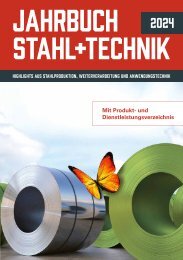STEEL + TECHNOLOGY 01/2020 EXTRACT
STEEL + TECHNOLOGY 01/2020 EXTRACT
STEEL + TECHNOLOGY 01/2020 EXTRACT
Create successful ePaper yourself
Turn your PDF publications into a flip-book with our unique Google optimized e-Paper software.
56 | WIRE & TUBE <strong>2020</strong><br />
Increasingly electrified<br />
Electric mobility to spread out much faster<br />
than expected<br />
According to the German Association of the Automotive Industry (VDA), electric vehicles are suitable for the<br />
market. A “young, still small market with high dynamics” has developed around e-cars - even though vehicles<br />
with combustion engine technology currently still dominate the global automotive market. Suppliers of the wire<br />
and cable industry are already picking up speed and see e-mobility as an opportunity.<br />
Wafios, globally leading manufacturer<br />
of wire and tube working<br />
machines, is convinced, the market<br />
potential is enormous. “Accordingly,<br />
the forecasts are positive”, Wafios emphasises.<br />
For this reason, e-mobility became<br />
the focus of the company’s attention<br />
already some years ago. “Technical triggers<br />
were enquiries from the automotive<br />
sector, both on the OEM side, supplier level<br />
and in the equipment sector about three<br />
years ago,” explains the supplier of<br />
machines for bending wire and tubes.<br />
E-mobility picked up speed.<br />
However, the industry is still “clear and<br />
concentrated on a few market participants”,<br />
explains Wafios. According to Alix-<br />
Partners Global Automotive Outlook 2<strong>01</strong>9,<br />
the global market share of electric drive<br />
units in terms of vehicles sold amounted<br />
to 2.7 per cent in 2<strong>01</strong>8. A share that is<br />
clearly expandable, which is shown by the<br />
growth rate of the e-drive of more than 65<br />
per cent. Thus, according to Outlook 2<strong>01</strong>9,<br />
the market is speeding ahead “in the irreversible<br />
market run-up”.<br />
According to VDA, electric mobility is<br />
coming faster than many expect. One reason<br />
is, for example, the tightening of regulations<br />
and the improved incentive systems for electric<br />
mobility in order to reduce CO 2 emissions.<br />
For example, there will be no new registrations<br />
for conventional drives in Norway<br />
from 2025 - the sale of electric cars will be<br />
promoted with massive tax incentives. The<br />
Netherlands, Ireland and Israel want to use<br />
only emissions-free vehicles from 2030. A<br />
sales ban on combustion engines is planned<br />
from 2040 in Great Britain and France. In the<br />
USA some states, such as California, plan to<br />
permit only emissions-free cars from 2040.<br />
In order to get their act together, suppliers<br />
have to target these figures.<br />
Globally, a drastic increase in hybrids and<br />
electric vehicles can be expected between<br />
<strong>2020</strong> and 2025. The VDA predicts that “by<br />
2030 a production share of electrified vehicles<br />
of 60 per cent or more worldwide is<br />
likely”. China will be a pioneer here - every<br />
third vehicle could be fully electric by 2030.<br />
In Western Europe, the share could rise to<br />
25 per cent due to stricter regulations and<br />
Electric mobility may come faster than many expect (Picture: Pixabay)<br />
driving bans. According to the association, a<br />
breakthrough in Africa and South America is<br />
not to be expected so soon. For Japan,<br />
Korea and North America, a share of hybrid<br />
vehicles of around 80 per cent would be<br />
conceivable. The car world is electrified - a<br />
realistic view.<br />
Huge investments required<br />
Car manufacturers and automotive suppliers<br />
must therefore make massive investments:<br />
The AlixPartners Global Automotive<br />
Outlook 2<strong>01</strong>0 reports that at least 202 billion<br />
euros will have to be spent globally<br />
over the next five years to master the technological<br />
change to the electric drive and<br />
the development, production and marketing<br />
of up to 300 planned new e-vehicles.<br />
“The level of investment is still out of all<br />
proportion to demand,” says Dr Elmar<br />
Kades, Global Co-Lead Automotive and<br />
Managing Director at AlixPartners. At the<br />
same time, the current and expected weak<br />
sales development for the next few years<br />
will increase the short-term pressure on the<br />
margins and cash flows of the suppliers,<br />
Kades continued. Weak sales and massive<br />
investments therefore coincide.<br />
Even though the situation is challenging,<br />
the wire and cable industry remains<br />
optimistic. “Electrically powered vehicles<br />
promise higher sales for our company<br />
because more or higher quality cables are<br />
needed,” explains Leoni. Hybrid vehicles,<br />
in particular, which contain both an electric<br />
and a combustion engine, require a higher<br />
product share from the company.<br />
High-quality cables are required in various<br />
areas of the electric car: In the charging<br />
cable from the charging station to the<br />
vehicle system and from the charging connection<br />
to the battery. Lines finally transport<br />
the electricity via the inverter to the<br />
<strong>STEEL</strong> + <strong>TECHNOLOGY</strong> 2 (<strong>2020</strong>) No. 1


















